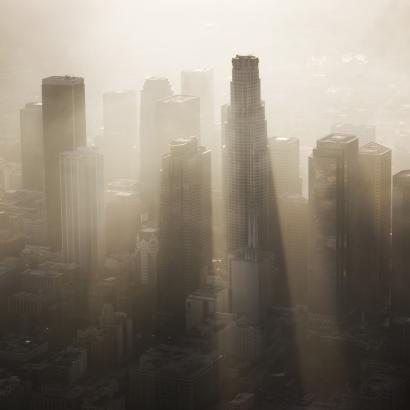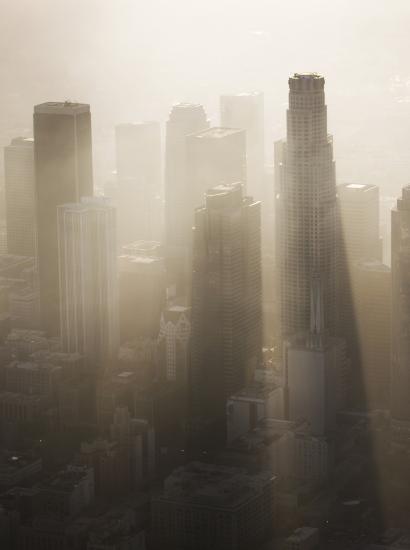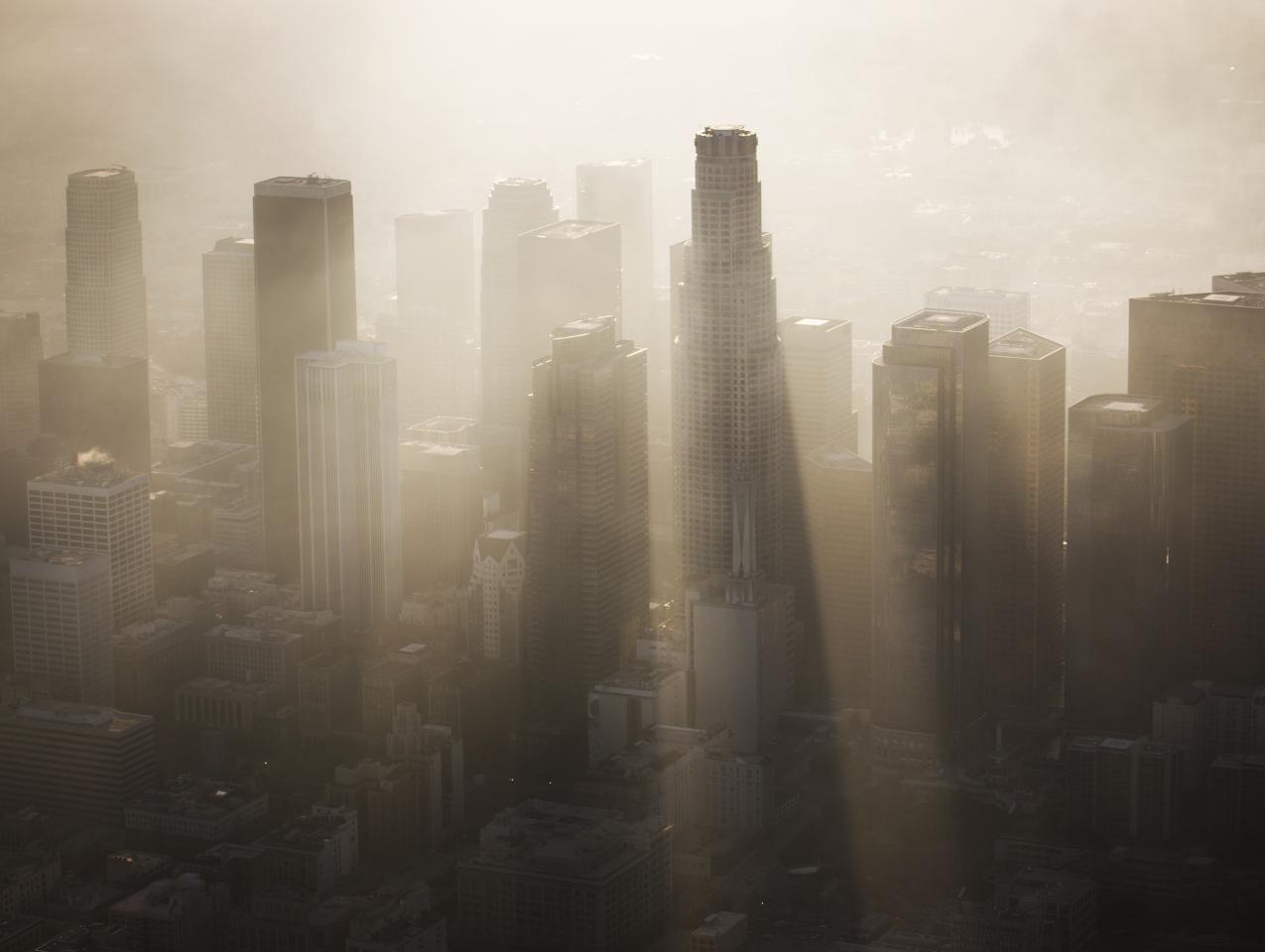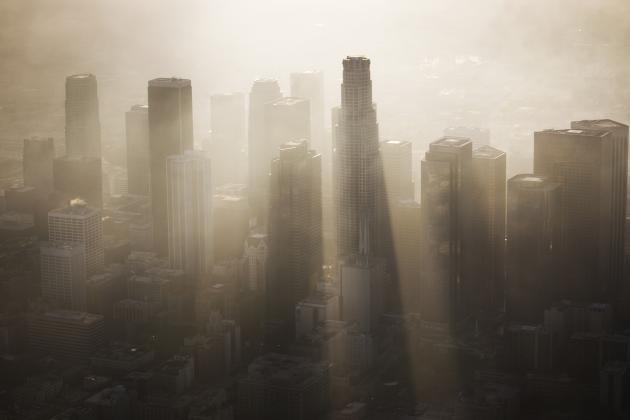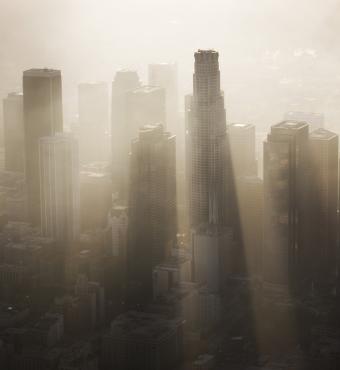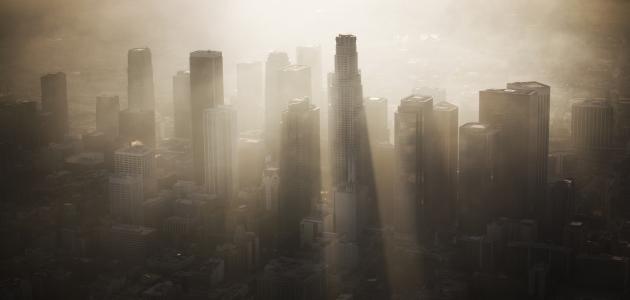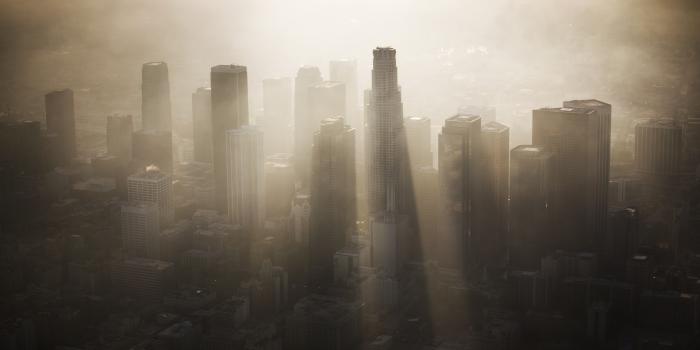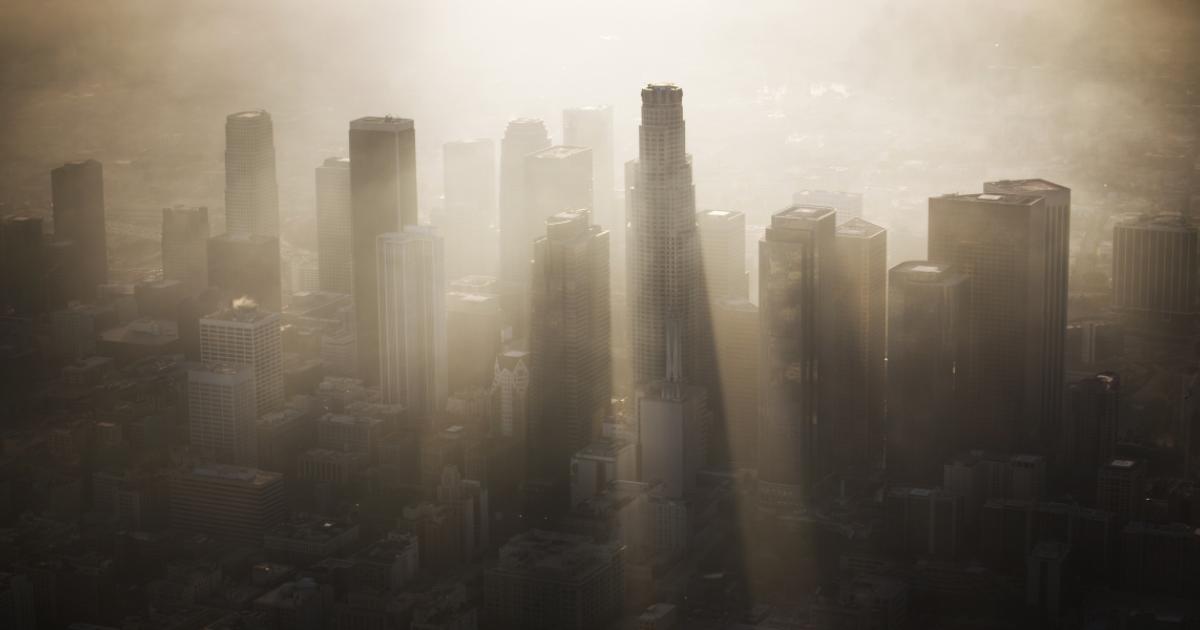- Energy & Environment
Introduction
The Mauna Loa Observatory in Hawaii sits two miles above sea level and over 2,200 miles from the nearest continent. For decades, scientists in this government laboratory have collected data on the atmosphere. In recent years, the world’s eyes have been fixed on a particular set of numbers coming out of Mauna Loa—readings of atmospheric concentrations of carbon dioxide (CO2), a key heat-trapping gas associated with climate change. Since the late 19th century, CO2 emissions have grown to unprecedented levels. In 2013, the daily average concentration of CO2 surpassed 400 parts per million for the first time in modern history.1 Emissions of CO2 continue to rise, reaching the largest amount ever recorded in 2018, according to the International Energy Agency.2 Greenhouse gas emissions have resulted in an increase of average global surface temperatures of approximately 1°C since the 1880s.3
The warming we have experienced to date has caused significant impacts already, including deeper droughts, more extreme precipitation, more intense storms, sea-level rise, and more heat extremes. In the words of the Third National Climate Assessment, a congressionally mandated report issued by the federal government in 2014, “Climate change, once considered an issue for a distant future, has moved firmly into the present.”4 As a result of the rising number of climate change-fueled disasters and the increasing reliance on assistance from the federal government, climate change has consistently earned a spot on the Government Accountability Office’s (GAO) “High Risk List” since 2013. In 2019, the GAO concluded that climate change “is a key source of federal fiscal exposure.”5 The authors of the Fourth National Climate Assessment, released in 2018, concluded that “the impacts of climate change are intensifying across the country, and that climate-related threats to Americans’ physical, social, and economic well-being are rising.”6 These impacts have made some land use and building practices more hazardous than they have been in the past.
Cities and urban areas already suffer acutely under the weight of climate change impacts—impacts they will encounter with growing frequency in the future. Significant governance gaps in how and where communities build make managing these risks particularly difficult. Few structures in the United States’ built environment were designed or constructed to account for future risks from climate change. Yet the United States is an urban nation. The 2010 Census estimated that over 80% of the population lives in urban areas, where they populate a rich built environment that depends on an interconnected system of infrastructure, including airports, roads, public transportation, railroads, housing, ports, energy generation, water and waste water treatment, communications, and health care delivery.7 Although approximately 90% of U.S. infrastructure is in private hands, governments must work with both public and private owners and operators to ensure functionality.8 And both publicly and privately owned infrastructure assets are already straining to perform up to task—even before accounting for climate change.9 In 2017, the American Society of Civil Engineers (ASCE) assigned American infrastructure a D+ grade overall due, in large part, to its aging and poor funding.10 The ASCE’s grade sent a message: our infrastructure, virtually none of which was built to withstand the kinds of extremes climate change threatens, is in need of major repairs if it is to help the rest of the built environment function properly.
Despite the vulnerabilities, building and land use practices in the United States have not accounted for projected risks from climate change. Our current planning and design methods are based on risks experienced in the past, not those we can anticipate in the future. Nor do they account for the fact that our communities are highly connected and networked. The failure to ensure the built environment’s performance in the wake of extremes also means that as communities suffer from the impacts of climate change, more people will face displacement from their homes and communities. An important way for the United States to address the challenges that climate change pose is to ensure that its investments in the built environment are more resilient11 to future risks.
In the face of the ever-more damaging impacts of climate change, the nation must close the governance gaps necessary to increase the resilience of its built environment. This will require a major shift in decision-making and a transition towards accounting for resilience to future risks. Climate change has introduced a “new normal” characterized by increasingly extreme events, and the impacts from climate change carry new risks that exploit the vulnerability of the built environment. However, there are straightforward, common-sense ways to address the governance gaps that discourage consideration of future risk in decision-making processes.
This paper examines the interrelated governance challenges emerging in the United States with respect to climate change and the built environment. These challenges center on how and where people live and the continued functioning of infrastructure. Making the right decisions on addressing these challenges can reduce catastrophic damage, avoid loss of livelihoods and homes, and even prevent loss of life. Improving decision-making in building and land use practices can help mitigate damages that occur due to the impacts of climate change in the United States.
The Way We Do Things Now
The nation’s current building and land use practices, which determine how and where structures are built, are not yet up to the task of ensuring resilience to disruptions from climate change. These practices continue to leave communities and citizens in harm’s way because of four emerging governance challenges. First, building and land use practices do not account for future extremes. Second, the interconnectedness of the built environment means that systems can fail if even just one sector fails under climate extremes. Third, traditional barriers between jurisdictions inhibit the type of cooperative planning needed to strengthen the built environment’s resilience to climate change. Fourth, the lack of planning for climate change-induced displacement leaves both migrant-sending and migrant-receiving communities vulnerable.
The Way We Build Matters
To a large extent, states have authority for governing building and land use practices within their borders. In many instances, however, states have delegated that authority to local jurisdictions. To ensure some level of life safety in buildings, most states—and certain local jurisdictions—adopt some version of model building codes and standards focused on life-safety to govern how structures are built. Those model codes and standards are developed by voluntary code organizations such as the International Code Council (ICC), a non-profit organization whose membership includes representatives from government and the building industry. However, this system does not always work perfectly to reduce risks from natural hazards.
Some jurisdictions do not even have a building code in the first place. In its Rating the States report published every three years, the Insurance Institute for Business and Home Safety (IBHS) found that eight of the 18 most hurricane-prone states in the United States lack a mandatory, statewide code.12 And even if a building code is in place, enforcement of the code may be lacking. Without enforcement, the likelihood of non-compliant construction increases
As Julie Rochman, former head of IBHS has noted, “Good building codes have little value if they are not well-enforced.”13
Among the states that lack a mandatory, statewide building code is Texas, which also lacks a statewide program for licensing building officials.14 When Hurricane Harvey struck Houston, Texas in 2017 (discussed in detail below), the city’s building code only required structures in the 100-year flood plain to be raised one foot above base flood elevation, in other words the level floods are expected to reach.15 However, the flood maps used to identify what buildings this applied to had not been updated since 2007, making them 10 years out of date when Harvey rolled around.16 Additionally, the maps used in Houston are based on historical rather than future flood risk and do not take climate change into account when calculating flood risk. In addition to the building code gaps that exacerbated flood vulnerability, a report by the Federal Emergency Management Administration (FEMA) found that construction problems relating to materials, installation of windows and doors, and securing roofs contributed $4.5 billion in wind damage during Hurricane Harvey.17
In the words of Brock Long, President Trump’s first FEMA Administrator, “Until we get building codes passed at local and state levels that are meaningful, then we’re going to see a lot of damage and destruction.”18 In the face of climate change, those codes must begin to account for the future risk of climate change. Virtually none of the model building codes and standards developed by the ICC and other code organizations yet consider future risks from climate change. When building codes do not consider future risks from climate change then increasingly extreme events can impose severe consequences. Take California’s “landmark” building code passed in 2008 requiring, among other measures, fire resistant roofs. Mandatory application of the code depends on whether a particular area is designated as “very high fire hazard severity zones” and where the state is financially responsible for fire protection.19 Notably, because the fire hazard severity zone designations do not yet account for increased risk from climate change, areas outside the official designations may still face severe fire risk but may not be obligated to adopt stricter code requirements. A decade after the code was adopted, the devastating Camp Fire killed 85 people and destroyed 14,000 homes.20
The Camp Fire was the deadliest and most destructive fire in recorded history in California.21 In the town of Paradise, California, most buildings were built before the 2008 code came into force and were therefore exempted from the more stringent requirements.22 An investigation by Gannett, McClatchy, Media News, and the Associated Press found that, of the 350 homes built to the stricter 2008 requirements, 51% survived the Camp Fire.23 Meanwhile, only 18% of the more than 12,000 homes built before the code survived.24 Homes built to the higher standards in 2008 and afterwards did have a higher survival rate than those built to lower requirements—but nearly half of them still burned away.
The Camp Fire revealed another challenge with building in fire-prone areas—few escape routes. Approximately, 350,000 Californians reside in areas with limited evacuation routes even though they are designated at the highest level of wildfire risk by CalFire, California’s state fire agency.25 Officials ordered all 27,000 Paradise residents to evacuate before the fire torched most of their homes and killed scores of people.26 In recognition of the risk to the built environment from wildfire even under the 2008 code, California’s state legislature is currently considering a bill to require developers in risky areas to increase fire protection, plan for evacuations, or provide safe areas for those who cannot evacuate.27 The measure would also require local governments to reduce the wildfire risk to existing structures. The California Building Industry Association opposes the measure on the grounds that it would make houses costlier and result in fewer homes being built.28
Weak building codes and lax enforcement reveal gaps in the governance of building practices. However, even when jurisdictions adopt and enforce model building codes, those codes may prove inadequate when it comes to climate change-exacerbated events. These gaps will only widen unless the nation changes its approach. Building codes aimed at protecting life safety based on the threat of past extremes may soon prove ineffective against future extremes. To protect people and property, the nation must address the challenge of improving its governance of building practices to ensure that they account for future risks to the built environment.
Where We Build Matters
Similar to building practices, land use practices are governed primarily at the state and local level in the United States. Although the ICC produces a model zoning code that states and local governments can adopt as it does with model building codes, the United States’ current land use practices do not adequately protect infrastructure and the built environment from climate change impacts. Specifically, all too often communities actually encourage development in areas where the impacts of climate change are mounting. Meeting the governance challenges involved in adapting land use practices to the impacts of climate change means, first and foremost, planning to account for future risks
Land use practices that do not account for future risks from climate change can increase vulnerability. Just consider what happened when Hurricane Harvey struck Houston, Texas in 2017. Prior to Harvey, Houston’s land use practices reflected a “hands-off” approach to development that aggravated its vulnerability to flooding from extreme storms. Proponents have lauded the absence of zoning laws in the city since at least the early 1970s, and by 2017 Houston had become the largest American city without any such regulations.29 Rather than restrict development in risky areas, the city largely paved over the surrounding prairie, bayou, and marshland. In fact, between 1996 and 2011, the total area of impervious surface in the greater Houston area increased by 25%, and the percentage of developed land in the city itself rose from 23% to 33% in roughly the same period.30 Since 2010, an investigation by the Texas Tribune and ProPublica found, at least 7,000 additional homes have been built in the 100-year floodplain in Harris County, where Houston is the county seat.31
Unsurprisingly, when Hurricane Harvey deluged Houston with over 50 inches of rain and set the record for most rain dropped by a single storm in U.S. history, tens of thousands of homes flooded. The flooding caused billions of dollars of damage to the infrastructure on which Houston depends.32 One year after Harvey, the Texas Commission on Environmental Quality reported that the storm either disrupted the operations of or directly damaged 40 wastewater treatment plants in the disaster area, affecting approximately 169,000 people.33 Furthermore, 44 health care facilities in the Houston area had to be evacuated.34 Almost every single one of Texas’s and Louisiana’s major oil refineries was either completely or partially shut down because of Hurricane Harvey.35 Energy, health care, water treatment—name a critical infrastructure sector and chances are Harvey seriously disrupted its operations.
Whether storms like Hurricane Harvey will become the new normal under climate change is an area of continued scientific investigation, and some recent literature is pointing in that direction. Indeed, studies in the field of attribution science since Harvey suggest that climate change likely increased the hurricane’s precipitation levels by 15–20%, and perhaps up to 37.7%.36 Yet, the problem is not contained to Texas. Nationwide, too, extreme storms may wreak increasing havoc on our coastal cities and infrastructure sectors. According to the Fourth National Climate Assessment, “The frequency of the most intense of these storms [tropical cyclones] is projected to increase in the Atlantic and western North Pacific… and in the eastern North Pacific.”37
But the problem does not just concern extreme storms. Unchecked growth in the wildland-urban interface (WUI)—where wildland vegetation meets the built environment—is partially responsible for the catastrophic wildfires California experienced in 2017 and 2018, including the Camp Fire.38 In 2010, the last year for which data are available, California was home to 4.5 million homes and 11 million people in the WUI—more than any other state in the continental U.S.39 In fact, the WUI added nearly 1,000 square miles in California between 1990 and 2000.40 Between 1990 and 2016, 60% of all new home construction in the United States took place in the WUI, making it the “fastest-growing land use type” in the country.41 Despite the devastation in California, the demand for greater development in the WUI has continued. Shortly after the Camp Fire, Los Angeles County approved a 19,000-home development in an area already designated as being a “high” and “very high” fire hazard severity zone.42 Year after year, homes, businesses, and the rest of the built environment will be burned or washed away because the governance of land use practices like these are not keeping up with the risks climate change poses.
Our Past Choices Regarding Infrastructure May Make Us Especially Vulnerable
Our past land use and building practices are proving no match for the kind of devastation that climate change impacts can bring. That can prove particularly costly when it comes to infrastructure failure in the face of climate extremes. For instance, the devastation caused by Hurricane Maria showed just how vulnerable infrastructure is in some parts of the country when faced with an unprecedented natural disaster. Even before Maria struck Puerto Rico, its electrical infrastructure was ailing. Roughly $9 billion in debt and relying on a quivering network of transmission lines long in need of repair, Puerto Rico’s electrical infrastructure turned to mincemeat when confronted with Maria’s force.43 Not long after Maria made landfall in Puerto Rico, its 175 mile-per-hour winds and almost 40 inches of rain brought down 80% of the island’s power lines, flooded most of its generators, and left 1.4 million—98% of utility customers—in the dark.44 Ultimately, Maria became the costliest disaster in the history of Puerto Rico and caused the largest blackout in U.S. history.45 It took 11 months to restore power to the island.46 In a way, Puerto Rico’s story is familiar. The island’s electrical infrastructure was not built with the impacts of climate change in mind, and catastrophe ensued.
Unlike Hurricane Harvey, sophisticated techniques in attribution science have not yet been directly applied to Hurricane Maria. However, early in 2019, researchers calculated the average precipitation levels of all 129 storms that have landed in Puerto Rico since 1956, and they found that Maria beat out every single one.47 Actually, the study found that the probability of observing a storm of Maria’s magnitude now is five times higher compared to observing such a storm in the 1950s.48 This may even be an underestimation since Maria was so intense that it actually destroyed some of the rain gauges collecting data during the storm.49 Going forward, decisions about where and how to develop the built environment and the infrastructure that supports it cannot reliably use the past as a guide.
Elsewhere in the country, similarly devastating consequences of climate change to infrastructure and the built environment are playing out. In California, unprecedented wildfires in 2018 may have led to contamination of fresh water supplies.50 The estimated cost of repairing the damage the Camp Fire caused to the water system in the town of Paradise alone totals $300 million.51 In Alaska, homes and infrastructure have recently sunken into the ground as warming temperatures have caused permafrost to melt.52 According to a recent study, about 70% of current infrastructure situated on Arctic permafrost around the world is at risk of damage from thawing by 2050.53
Or consider climate vulnerabilities in the nuclear energy sector. In Connecticut in 2012, safety protocols at the Millstone nuclear power plant automatically shut the plant down because warmer than average ocean temperatures meant that the water was unable to cool the reactors.54 In addition to Millstone, nuclear plants in Delaware, New Hampshire, and New Jersey have been found to be especially vulnerable to coastal flooding even before climate change-related variables like sea-level rise are used to estimate their flood risk.55 Some places, like the Turkey Point nuclear power plant 35 miles outside Miami, Florida, have taken steps to reduce their risk. Turkey Point was designed to withstand a 16-foot storm surge, but there’s one problem.56 Storm surge projections from a major hurricane now range between 17.4 and 19.1 feet for some parts of the plant.57 There is still more work to do to reduce the vulnerability of the nation’s nuclear sector. While U.S. nuclear operators have been driven to adopt new risk mitigation approaches including response contingencies and pre-positioning of flood recovery equipment, the U.S. Nuclear Regulatory Commissions has rejected a staff recommendation that nuclear plants update their risk assessments periodically to reflect future climate risk.58
The list goes on and on, showing the same pattern with regard to infrastructure many times over. Infrastructure assets in the United States were not built to withstand the impacts of climate change, leaving them vulnerable to damage and destruction. Governing the incorporation of future risk in infrastructure design, construction, and maintenance is of critical importance. These assets are often intended to last decades. Building them to withstand the extremes of the past will not keep them or us safe. With climate change, the past is an increasingly unreliable guide for the future.
As We Make Future Investments, We Can’t Afford to Keep Making Mistakes
Unfortunately, across the country, communities have made recent infrastructure investments that have already proven vulnerable to climate change. Take, for example, Norfolk, Virginia, and the surrounding region of Hampton Roads, which has installations for every military service branch and is home to much of the U.S. Navy fleet. It is also suffering one of the highest rates of relative sea-level rise, driven by both climate change and continued subsidence of the land it is built upon, and routinely suffers tidal flooding. In 2011, Norfolk began operating a light rail system, appropriately called the Tide, in part to help military personnel (90% of whom live off base) get to work. The system cost over $300 million, much of which came from a federal grant, but failed to account for sea-level rise and now regularly faces the risk of “sunny-day flooding.”
When California recently constructed a new section of the San Francisco Bay Bridge, it did not account for future sea-level rise.59 The toll booth areas leading up to the bridge already need flood remediation. Nor did New York City account for sea-level rise when it constructed the flood barriers for the South Ferry subway station in Manhattan, which cost approximately $500 million and flooded during Hurricane Sandy. It’s not just local governments that continue to make infrastructure investments that are vulnerable to climate risk—the federal government does, too.60 When the Department of Defense invested close to a billion dollars for a new radar installation on the atoll of Kwajalein in the Pacific in 2014, it failed to consider sea-level rise.61 A report commissioned by the Department in 2018 found salt water inundation from sea level rise would threaten fresh water supplies on the island in the near future.62
Our Interconnected Infrastructure Is at Increasing Risk
Extreme events worsened by climate change that stress individual infrastructure assets can also lead to stresses within entire infrastructure systems. Because the United States’ infrastructure is characterized by a high degree of interdependence, disruptions that occur in infrastructure sectors upstream can also lead to disruptions downstream. In other words, even though the impacts of climate change might not directly affect each infrastructure sector on its own, every sector could be affected because they rely on each other to move goods, services, and information around the country.
The nation’s experience with Hurricane (and tropical storm) Sandy provided a vivid example of the chain reaction that occurs when failures in one infrastructure sector lead to cascading failures in other sectors. In October 2012, when Sandy slammed into the United States’ East Coast, it underscored not only the damage extreme weather events can do to individual infrastructure projects but also to a highly vulnerable, interdependent system. Sandy stretched over 1,000 miles in diameter and directly affected 24 states. Landing during a full moon at high tide, it cut a huge swath of destruction. More than 650,000 homes were seriously damaged or destroyed.63 Over 200 energy assets were affected across the northeastern United States, and more than 8 million people went without power as Sandy caused the third largest blackout in U.S. history.64 The lack of electricity and flooding resulted in the spillage of roughly 11 billion gallons of waste water into rivers, canals, and bays mostly in New York and New Jersey.65 The storm impacted the health care, transportation, communications, and financial sectors.66 Every one of the subway tunnels underneath the East River flooded. New York’s Metropolitan Transportation Authority ended up relying on outside help to pump the floodwaters because the electrical grid being down meant that it also knocked out the subway’s own pump system.67 Storm debris and the lack of power prevented tanker trucks from delivering gasoline and prevented gas stations from pumping even when they received the gas.68 Hospitals across New York City evacuated some 6,500 patients during Hurricane Sandy.69 Without power, one out of every four dialysis patients in New York City went without regular treatment because the one-two punch of lost power and flooding closed outpatient centers.70 The storm “revealed that even though several major hurricanes [had] struck the metro New York Area over the past 150 years and advance warning was given…lifeline infrastructure sectors were severely compromised due to a lack of investment in mitigation measures and adequate planning for managing cascading disruptions across interdependent systems.”71
In the United States, infrastructure sectors are connected to each other as if in a spider’s web. Yet no mechanisms exist in our country to holistically govern decisions that affect how and where infrastructure is built. Hurricane Sandy showed the nation just how devastating such a vulnerable network is to extreme events. As climate change aggravates the severity of disasters like Sandy, managing infrastructure interdependence to reduce vulnerability must become standard practice in government and the private sector.
Climate Change Impacts Do Not Stop at Our Jurisdictional Boundaries
Climate change does not honor our jurisdictional boundaries. The impacts of climate change may unfold in jurisdictions that have quite different ways of governing building and land use practices to deal with climate change or not. Moreover, although jurisdictions may face a common threat in the same area, the choices they make could affect other jurisdictions substantially.
Take the threat of sea-level rise for example. If a community chooses to “harden” its coastline with a sea-wall or engage in “beach replenishment” to replace washed away sands, it can push water into neighboring jurisdictions. Alternatively, if a city decides not to protect against rising seas, that decision could impact risks to neighboring cities and should make a difference in decisions about how much protection they should invest in and where. Similarly, climate change risks to critical infrastructure systems that cross jurisdictions, such as passenger and cargo rail systems, threaten costly disruptions to entire regions’ security and stability. Resolving cross-jurisdictional governance challenges that arise with climate change is urgently needed. Sea-level rise along densely populated coasts directly threatens almost 40% of the U.S. population.72 On the Gulf Coast, a four-foot rise in sea levels—which falls below the upper extremes of many model predictions—would leave 27% of major roads, 9% of rail lines, and 72% of ports prone to flooding.73 The cross-jurisdictional challenges of governing such disruptions can seem daunting.
The cross-jurisdictional governance challenges involved with climate change can also be significant when planning for wildfire mitigation. Good forest management and proactive mitigation techniques can reduce the threat of wildfires. But if neighboring jurisdictions do not both practice good fire-safety techniques, fires can jump jurisdictional boundaries quickly. Take, for example, the issue of fuels management. If authorities in one location do not require rigorous brush clearance, an adjacent community may be at heightened risk of fires spreading, regardless of its own brush clearance efforts. Conversely, those communities who do chose to manage fuels do so knowing that some of the benefit of their expenditures will go to their neighbors, which may result in underinvestment. In the face of climate change impacts, jurisdictions will need to find ways to improve joint decision-making and coordination of responses.
Some jurisdictions in the United States have begun to grapple with the governance challenges involved with the cross-jurisdictional impacts of climate change. In the nine counties and approximately 100 cities surrounding the San Francisco Bay, there are roughly 13,000 homes—$8.6 billion worth of real estate—at risk of chronic inundation from sea-level rise by 2045.74 Each of these local jurisdictions has its own governance structure that makes local land use decisions. The San Francisco Bay Conservation and Development Commission, a state-created commission established in the 1960s, developed the “Adapting to Rising Tides” initiative to help coordinate a regional response to sea-level rise. The program has recognized that governance is a significant obstacle, concluding that “the effects of climate change present serious challenges to the ways that agencies, organizations, businesses, property owners and Bay Area residents have traditionally done planning and made decisions.”75 According to the Commission, “governance needs to be considered first if the Bay Area is to increase its resilience.”76
On the other side of the country, leaders in south Florida created the Southeast Florida Regional Compact a decade ago. The goal was to increase collaboration across jurisdictional boundaries when dealing with challenges such as hotter temperatures, stronger storms, and sea-level rise. Like San Francisco, the region encompassed a broad array of jurisdictions including over 100 cities and four counties. The Compact set a regional planning scenario for sea-level rise—six to ten inches by 2030 and up to 5 feet by 2100. It also conducted a joint vulnerability assessment evaluating the regions risks and created a regional climate action plan. All of this was accomplished with no top-down authority—only the agreement among local governments to work together.
These regional efforts are the exception rather than the rule for communities across the United States. Despite the risks and the cross-jurisdictional nature of climate change, most places in the United States—and the world, for that matter—are still struggling against the threat that climate change poses to communities in isolation. Without mechanisms to ensure cross-jurisdictional governance, communities may face additional risks as a result of choices their neighboring communities make. And even the nascent efforts at cross-jurisdictional planning may not prove up the job. For such efforts to be influential, they must be able to draw support from their constituents. As one researcher found, regional collaboratives “have done little as yet to push for…governance changes commensurate with the levels of climate impacts they project.”77
Pathways for Better Governance to Achieve Climate Resilience in the Built Environment
Although notable examples of resilience have emerged around the world—including London’s Thames Estuary Project, China’s Sponge City initiative, and the Rain Ready Chicago program—designing and building projects to account for climate change is not widely understood or considered in most American communities. Policy efforts focused on resilience are still in the early stages of experimentation and implementation.78 Much work needs to be done to understand the viability of various policy options. If, however, the nation continues to build as it has in the past, it will leave itself vulnerable to increased damage from the impacts of climate change. Relying on past experience alone to guide decisions about the built environment, including what we have already constructed, will not keep communities safe.
Going forward, the federal government should not only make sure its investments reflect climate resilience but also assist communities in finding ways to make their land-use and building practices more resilient to climate change impacts. A good place to start is federal investment in the built environment. The government should require federal agencies to screen any investments they make for climate resilience. In doing so, it should require that, where federal taxpayer dollars are used, new infrastructure is designed to deal with climate impacts in the foreseeable future. This is particularly important with regard to costly infrastructure that may have a long service life. It should also focus on helping owners and operators of infrastructure assets find ways to mitigate the increased risks posed by interconnected infrastructure systems.
Moreover, when the federal government gives funding for development assistance, screening beneficiary communities for climate resilience could incentivize those communities to take proactive steps to reduce their risk. In this regard, the federal government could require communities to produce hazard mitigation plans that adequately identify and address their climate risk levels to access grant funding. It has in fact done this with the Coastal Barrier Resources Act in 1982 which aimed, among other things, to discourage development in areas vulnerable to storm surge and hurricanes and reduce wasteful government spending. The acreage governed by the Act has grown from the original 450,000 acres to 3.5 million acres today. Some have argued that similar provisions should be adopted for areas at high risk of wildfire.79
In addition to its own investments, the federal government should also provide incentives for state and local governments to consider nature-based solutions to mitigate risk as either a complement to or substitute for gray infrastructure. A combination of conventional infrastructure and nature-based infrastructure may increase resilience overall.80 In 2019, the World Bank and World Resources Institute published research finding that integrating “green” infrastructure—such as forests, floodplains, and wetlands—with traditional “gray” infrastructure systems can produce lower costs and more resilient services. It further concluded that this integration helps deliver a “triple-win” that could benefit the economy, communities, and the environment.81
The federal government could play a larger role in supporting code organizations to accelerate the development of climate-resilient codes and encourage state and local communities to adopt them. Those new model codes should focus on ensuring the performance of buildings and infrastructure when they experience extreme events and conditions. This could come in the form of financial support or additional participation in the code-making process by federal experts as the GAO has recommended.82 In the absence of climate-resilient building codes, the federal government should provide financial incentives to communities that adopt the latest version of model codes. It should also ensure that it applies the latest building codes to its own holdings. After all, a 2019 study concluded that, within the United States, adoption of the latest model codes would result in national savings of $11 for every $1 spent on building to code in the form of fewer business losses, lower property damage, and the like.83
The federal government should engage more actively in improving quality and access to information about climate resilience. For example, it could provide technical assistance for researchers studying how to improve cost-benefit analyses so that they do not underestimate the benefits of resilience.84 It is estimated that every $1 spent on hazard mitigation saves between $4 and $11 in reduced damages.85 Yet, the “lumpy” nature of infrastructure investment and its long service life can make it difficult for elected politicians to invest in resilience.86 Cost-benefit analyses, supported by the federal government, that reflect the added benefit over long time frames could strengthen the case for resilience.87 Additionally, the federal government could promote more robust risk assessments at the local level by providing detailed information about hazards to local government officials.
Development of regional governance mechanisms to address climate change impacts is also needed. Governing regional planning for climate change could benefit from the provision of financial and other incentives by governments and philanthropic organizations to regions and communities for projects that reflect joint planning. This could include, for example, the funding of pilot regional planning efforts with incremental incentives for development and implementation of a binding plan or creation of a national risk mitigation fund to fund community resilience projects jointly designed and implemented at a regional level. Or, it could involve increased use of joint powers authorities to allow for increased coordination, legislative creation of special districts and regional authorities to address the impacts of climate change, conditioning receipt of federal disaster aid on proof of participation in regional hazard mitigation planning, or creation of specialized commissions to reach regional decisions. The federal government should also increase its own efforts to coordinate with foreign governments to ensure that critical infrastructure sectors that cross international boundaries are resilient to extreme events.88
Federal support for educating engineers and urban planners about the impacts of climate change can also enhance resilience. The federal government could provide incentives to universities to improve their course offerings and develop continuing education programs for practitioners. It could also provide financial support to develop technologies that help estimate and assess the risks from climate change and make these available on public platforms. Or, it could create a partnership with industry and researchers to generate publicly available data on infrastructure interdependencies, climate risks, and vulnerability in urban areas.89 Scenario modelling of possible infrastructure failures could help identify where investments will provide the greatest “bang for the buck” in this regard. It could develop a scheme of transferable development rights that would direct development away from at-risk areas and towards areas of lower risk. 90 For federally funded building projects, it could create and require use of mandatory national standards that account for future risk. It could create design and innovation challenges to fund pilot initiative focused on climate resilience in the built environment. Since communities will not be able to upgrade all infrastructure, better federal analysis regarding the likelihood of failure of existing infrastructure could improve regional and local decision-making.
The federal government could also take steps to rein in its “bailout” relief packages after a disaster. According to the GAO, in 2017 four “disasters—Hurricanes Harvey, Irma, Maria and the California wildfires—created unprecedented demand for federal disaster help.”91 For fiscal years 2005 through 2014, federal agencies obligated over $277 billion in disaster assistance funding. The GAO estimates that that number will continue to grow thanks to the increasing number of disasters and their rising costs. In the face of increasing reliance on federal recovery support, the federal government needs to provide incentives to mitigate risk.92 For example, the federal government could provide incentives for states and communities to invest in pre-disaster mitigation. One promising idea is a proposal by FEMA to create a “disaster deductible” that would condition a state’s receipt of FEMA funds for recovery on efforts to reduce risk pre-event.
Similarly, Congress urgently needs to reform the National Flood Insurance Program (NFIP). The program, originally designed to reduce the increasing costs of flood damage to the federal government, is deeply in the red. Because the NFIP subsidizes premiums, its rates do not reflect the full risk of flood losses. The GAO has concluded that reform of the NFIP is required to reduce taxpayer exposure and build resilience to flooding.93
Countless other promising pathways exist for the federal government to promote resilience at the state and local level to the impacts of climate change. Developing the political will to drive any and all of these pathways forward will remain challenging. Politicians may fear a diminution in their power, a loss of tax revenues, or meddling in local affairs. They also may feel pressure to address more immediate concerns instead of long-range risks that become more acute over decades rather than months. Any regional decision to prepare for climate change will, in all likelihood, create winners and losers. Yet finding ways to reward communities for making choices that contribute to resilience is essential.
Addressing Climate Change-Induced Displacement
Following Hurricane Maria (discussed in depth above), Puerto Rico lost 4% of its population, according to the U.S. Census—the greatest loss of population in the island’s recorded history in the estimation of one demographer.94 Climate change impacts destroy homes and force people to move.
In the United States, estimates suggest that every single state would be affected by migration in some form or another if sea levels were to rise by the highest projections of 1.8 meters by 2100, which would place approximately 13.1 million persons at risk of displacement.95 In the next 25 years, 62,000 properties in New Jersey will be at risk from coastal flooding.96 Given the significant numbers of people involved, it is not hard to see how local receiving communities could face increased pressures from migrants, many of whom may be unemployed, homeless, or both. One researcher, who has modeled displacement from heavily populated coastal communities in the United States as a result of unmitigated sea-level rise, warns that the anticipated redistribution of populations has the potential to stress areas unprepared to accommodate the waves of migrants.97 A study in 2017 found that the poorest states and counties will disproportionately suffer economically as temperatures rise.98 Presumably, this will further drive displacement as people search for more economically healthy communities. Projected temperature increases in the Southwest may drive people who have the means to search for more hospitable ground.
Coastal retreat—sometimes called planned retreat or managed retreat—has been a subject of discussion for many years among the citizens of Del Mar, California. In 2015, the city formed a commission focused exclusively on understanding Del Mar’s vulnerability to flooding and how it might increase with climate change.99 Despite the commission’s findings that the city could experience 1.4–5.5 feet of sea-level rise by 2100, Del Mar’s local leaders took the option of coastal retreat off the table.100 Amanda Lee, Del Mar’s senior city planner, says, that “even the mere discussion of managed retreat, in the minds of some, completely devalues their property,” which other local leaders say makes coastal retreat “unfeasible.”101 As climate change-induced migration increasingly becomes a reality with which cities like Del Mar will have to contend, governing the challenge lags behind.
When should a community retreat? To date, the United States has struggled to find an answer. After Hurricane Sandy, New York offered buy-out programs for many communities with the idea that swaths of land could be cleared of homes and turned into green space. Some local mayors declined to participate in the program because it would reduce their tax base. Others found that because the program was voluntary, hold-out homes meant that services needed to continue, and no new green space would be created. As with building codes, the consequence of allowing building to continue in at-risk areas can lead to increased losses, losses that may fall on the federal government. Moreover, once a particular area is developed, there is enormous pressure to build back after a disaster in exactly the same place.
No strategic plan exists to manage migration on the scale that climate change will cause. For both internal and external displacement, governments need to focus on building the structures that help keep people at home, and if they must move, provide assistance to them and the communities that are receiving them. To date, such efforts are nascent both nationally and internationally and need to be scaled up quickly. Locally, communities must build programs to ease migrants’ transition so that social tensions remain in check. Such assistance could take the form of grants to build additional housing in anticipation of their arrival, job placements, tax breaks to cover costs, and reciprocity in professional licensing requirements. The federal government could also contribute financially to the construction of needed infrastructure in the receiving communities. The need to act is urgent: ungoverned migration can stress those displaced, sending and receiving communities, and governments.
The federal government could also create new structures to address the challenges ahead. For example, an institute of climate resilience could tackle the issues of displacement, infrastructure resilience, and cross-jurisdictional planning. Or a new federal agency focused on internal migration could zero in on meeting the challenges and needs of the millions of people who be displaced from their homes by climate change and in search of new opportunities in new locations. Similarly, the federal government could create an independent board appointed by Congress to examine vulnerabilities to the nation’s built environment from climate change-exacerbated disasters and make recommendations for improvements. It could also create a central place to access information and tools and develop a cadre of consultants who could provide information regarding local vulnerabilities and federal programs that offer assistance. Developing a “customer-friendly” approach to the science and aid programs offered by the federal government would be an important way to jump-start efforts to mitigate the risks from climate change.
Conclusion
In 2018, the International Panel on Climate Change (IPCC), a United Nations-sponsored group of climate scientists from nations across the globe, warned that a rise in global average temperatures of 2°C, compared to 1.5°C, above pre-industrial levels by 2100, the additional heat will expose tens of millions of additional people to extreme, life-threatening heat waves, severe droughts and water shortages, flooding from sea-level rise, declining crop yields, and more.102 Under new climate regimes, storms whip across towns, counties, states, and even countries. Sea-level rise creeps higher along coasts, ignoring jurisdictional boundaries. Drought cuts across huge swathes of land crossing national, state, and local lines. When it comes to reducing risks from future climate impacts, those jurisdictional boundaries can hamper progress greatly. The cross-jurisdictional impacts of climate change complicate the challenge of managing climate risks. And if climate risks are not managed well, it can disrupt communities.
In the absence of significant improvement in infrastructure resilience, the annual economic losses to urban infrastructure alone from natural disasters is estimated to increase to $415 billion by 2030, up from a current average of $250 to $230 billion. For example, the 2017 hurricane season was the most expensive in U.S. history, with $265 billion in damage from Hurricanes Harvey, Maria, and Irma alone.103 And, as Hurricane Sandy demonstrated, failure in some sectors—like electricity, waste water, and transportation—can have devastating impacts on security, public health, and the economy.
The United States is not alone in the challenges it faces from climate change in the built environment. Climate change impacts already stress an estimated 70% of the world’s cities.104 As climate impacts accelerate, they will impact ever-greater populations, populations that will be based in cities. By 2050, the world’s population will grow from 7.7 billion to 9.8 billion.105 By then, two-thirds of the world’s population will live in cities; 2.5 billion more people than today.106 Within the United States, the U.S. Census Bureau projects that, depending on levels of net immigration, the nation’s population may grow to roughly 400 million by 2050.107 Global building stock is expected to increase at, in the words of Bill Gates, “the equivalent of adding another New York City monthly between now and then.”108
From just 2015 to 2030 an estimated $90 trillion will be spent on infrastructure worldwide.109 Climate change requires that we “revisit the overarching governance models” for how and where we build.110 We need to find ways to better address the growing risks. Improving governance of building and land use practices to prepare for the impacts of climate change is an important first step.
Alice Hill is a research fellow at the Hoover Institution. Before coming to Hoover, she served in the Obama administration as special assistant to the president and senior director for resilience policy on the National Security Council. She also served as senior counselor to the secretary of the Department of Homeland Security and as supervising judge on the Los Angeles Superior Court and chief of the major frauds division of the Los Angeles U.S. Attorney’s office.








